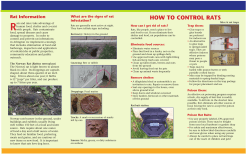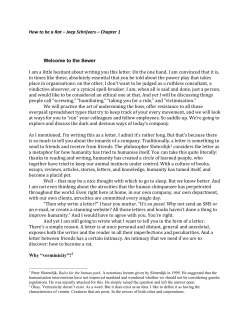
Datasheet: 84500505 Product Details
Datasheet: 84500505 Description: RAT ANTI SUBSTANCE P Specificity: SUBSTANCE P Format: S/N Product Type: Monoclonal Antibody Clone: NC1/34 Isotype: IgG2a Quantity: 0.1 ml Product Details Applications This product has been reported to work in the following applications. This information is derived from testing within our laboratories, peer-reviewed publications or personal communications from the originators. Please refer to references indicated for further information. For general protocol recommendations, please visit www.abdserotec.com/protocols. No Not Determined Suggested Dilution Immunohistology - Frozen Yes 1/100 - 1/200 Immunohistology - Paraffin(1) 1/100 - 1/200 Immunofluorescence Where this product has not been tested for use in a particular technique this does not necessarily exclude its use in such procedures. Suggested working dilutions are given as a guide only. It is recommended that the user titrates the product for use in their own system using appropriate negative/positive controls. (1)This product does not require antigen retrieval prior to staining of formalin fixed, paraffin embedded sections. Species Cross Reacts with: Pig, Pigeon, Bichir, Rabbit, Human, Bovine, Guinea Pig, Calanus sp., Cancer sp., Reactivity Panilurus sp., Homarus sp., Mudpuppy, Lamprey, Crayfish, Zebrafish, Bullfrog, Cockroach, Sheep, Cowbird, Rat, Spadefoot toad, Chicken, Chinchilla Based on sequence similarity, is expected to react with:Mammals, Crustacea, Amphibia N.B. Antibody reactivity and working conditions may vary between species. Product Form Tissue Culture Supernatant - liquid Preservative Stabilisers 0.05% Thiomersal Immunogen Substance P conjugated to Bovine Serum Albumin. External Database Links UniProt: P20366 Related reagents Entrez Gene: 6863 TAC1 Related reagents Page 1 of 4 Synonyms NKA, NKNA, TAC2 Fusion Partners Spleen cells from immunised Wistar rat were fused with cells of the NS1/1-Ag 4-1 myeloma cell line. Specificity Rat anti substance P antibody, clone NC1/34 recognizes the COOH terminal end of substance P, a short polypeptide neurotransmitter that regulates the excitability of dorsal horn nociceptive neurons. It is known to have a role in several physiologic activities such as pain transmission, the vomiting reflex, salivary secretion and smooth muscle contraction. 5% reactivity is observed with eledoisin. It does not react with Leu or Met-enkephalin, somatostatin or beta-endorphin. References 1. Kozsurek, M. et al. (2009) Nonselective innervation of lamina I projection neurons by cocaine- and amphetamine-regulated transcript peptide (CART)-immunoreactive fibres in the rat spinal dorsal horn. Eur J Neurosci. 29: 2375-87. 2. Cuello, A.C. et al. (1980) Use of monoclonal antibodies in immunohistochemistry with special reference to the central nervous system. Brain Res. Bull. 5: 575-587. 3. Pioro, E.P. et al. (1985) Loss of substance P immunoreactivity in the nucleus of the spinal trigeminal tract after intradural tumour compression of the trigeminal nerve. Neurosci Lett. 58: 7-12. 4. Mai, J.K. et al. (1986) Substance P in the human brain. Neuroscience 17: 709-739. 5. Cuello, A.C. et al. (1979) Detection of substance P in the central nervous system by a monolconal antibody. Proc. Natl. Acad. Sci. USA 76: 3532-3536. 6. Czujkowska, H. and Arciszewski, M.B. (2011) Expression of corticotropin releasing factor (CRF) in the enteric nervous system of the jejunum of sheep Veterinarni medicina 56: 551-60. 7. Kato, A. et al. (2012) Endocannabinoid-Dependent Plasticity at Spinal Nociceptor Synapses. J Physiol. Aug 28. [Epub ahead of print] 8. Arciszewski, M.B. et al. (2009) Expression of vasoactive intestinal polypeptide, substance P and neuropeptide Y in jejunal enteric nerves is altered in rabbits suffering from long term Trichinella spiralis infection: an immunohistochemical study Veterinarni Medicina, 54: 589–597 9. Bulc, M. et al. (2012) Immunohistochemical characterization of the porcine nodose ganglion. Acta Histochem. pii: S0065-1281(12)00142-0. 10. Boorsma, D.M. et al. (1982) Direct immunocytochemistry with a horseradish peroxidaseconjugated monoclonal antibody against substance P. J Histochem Cytochem. 30: 1211-6. 11. Pioro, E.P. et al. (1984) Loss of substance P and Enkephalin immunoreactivity in the human substantia nigra after striato-pallidal infarction Brain Res. 292: 339-47. 12. Mortimer, S.T. et al. (1990) Immunohistochemical identification of calcitonin gene-related peptide and substance P in nerves of the bovine parathyroid gland. Cell Tissue Res. 261: 339-45. 13. Galligan, J.J. et al. (1988) Changes in surviving nerve fibers associated with submucosal arteries following extrinsic denervation of the small intestine. Cell Tissue Res. 253: 647-56. 14. Horn, J.P. and Stofer, W.D. (1989) Preganglionic and sensory origins of calcitonin gene-related peptide-like and substance P-like immunoreactivities in bullfrog sympathetic ganglia. J Neurosci. 9: 2543-61. 15. Verhaert, P. and De Loof, A. (1985) Substance P-like immunoreactivity in the central nervous system of the blattarian insect Periplaneta americana L. revealed by a monoclonal antibody. Histochemistry. 83: 501-7. 16. Polgár, E. et al. (2007) A population of large neurons in laminae III and IV of the rat spinal cord that have long dorsal dendrites and lack the neurokinin 1 receptor. Eur J Neurosci. 26: 1587-98. 17. Nowicki, M. et al. (2007) Peptidergic and nitrergic innervation of the pineal gland in the domestic pig: an immunohistochemical study. Anat Histol Embryol. 36: 311-20. Page 2 of 4 18. Nair-Roberts, R.G. et al. (2006) Distribution of substance P reveals a novel subdivision in the hippocampus of parasitic South American cowbirds. J Comp Neurol. 496: 610-26. 19. Song, Y. et al. (2013) Bilateral increase in expression and concentration of tachykinin in a unilateral rabbit muscle overuse model that leads to myositis. BMC Musculoskelet Disord. 14: 134. 20. Szczurkowski, A. et al. (2013) Morphology and immunohistochemical characteristics of the pterygopalatine ganglion in the chinchilla (Chinchilla laniger, Molina) Polish Journal of Veterinary Sciences Vol. 16: 359–368 21. Pidsudko, Z. (2013) Immunohistochemical Characteristics and Distribution of Sensory Dorsal Root Ganglia Neurons Supplying the Urinary Bladder in the Male Pig. J Mol Neurosci. Sep 20. [Epub ahead of print] 22. Zacharko-Siembida, A. et al. (2013) Co-expression patterns of cocaine- and amphetamineregulated transcript (CART) with neuropeptides in dorsal root ganglia of the pig. Acta Histochem. pii: S0065-1281(13)00182-7. 23. Dudek, A. et al. (2012) Immunohistochemical characterization of neurons in the vestibular ganglion (Scarpa's ganglion) of the pig. Pol J Vet Sci.15: 499-507. Store at +4oC or at -20oC if preferred. Storage Storage in frost-free freezers is not recommended. This product should be stored undiluted. Avoid repeated freezing and thawing as this may denature the antibody. Should this product contain a precipitate we recommend microcentrifugation before use. Shelf Life 18 months from date of despatch. Health And Safety Information Material Safety Datasheet Documentation #10522 available at: http://www.abdserotec.com/uploads/MSDS/10522.pdf Regulatory For research purposes only Related Products Recommended Secondary Antibodies Rabbit Anti Rat IgG (STAR21...) HRP Goat Anti Rat IgG (STAR73...) RPE Goat Anti Rat IgG (STAR69...) FITC Rabbit Anti Rat IgG (STAR17...) FITC Goat Anti Rat IgG (STAR131...) Alk. Phos., Biotin Rabbit Anti Rat IgG (STAR16...) DyLight®800 Rabbit Anti Rat IgG (STAR20...) RPE Goat Anti Rat IgG (STAR80...) FITC Goat Anti Rat IgG (MOUSE ADSORBED) (STAR71...) DyLight®549, DyLight®649, DyLight®800 Goat Anti Rat IgG (STAR72...) North & South America Tel: +1 800 265 7376 Worldwide Fax: +1 919 878 3751 Email: abd_sales_us@bio-rad.com HRP Tel: +44 (0)1865 852 700 Europe Fax: +44 (0)1865 852 739 Email: abd_sales_uk@bio-rad.com 'M256145:140609' Printed on 08 Oct 2014 Page 3 of 4 Tel: +49 (0) 89 8090 95 21 Fax: +49 (0) 89 8090 95 50 Email: abd_sales_de@bio-rad.com © 2014 BioRad Laboratories Inc | Legal | Imprint Page 4 of 4
© Copyright 2025





















